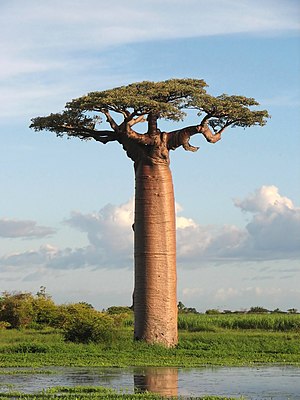Adansonia grandidieri
| Adansonia grandidieri | ||||||||||||
|---|---|---|---|---|---|---|---|---|---|---|---|---|

Adansonia grandidieri |
||||||||||||
| Systematics | ||||||||||||
|
||||||||||||
| Scientific name | ||||||||||||
| Adansonia grandidieri | ||||||||||||
| Baill. |
Adansonia grandidieri is a species of baobab trees ( Adansonia ) in the mallow family (Malvaceae). It is similar to Adansonia digitata , but has upright flowers . Thespecies nativeto Madagascar is used intensively there.
description
Vegetative characteristics
Adansonia grandidieri are massive deciduous trees up to 25 meters high with purple, smooth bark . Fully grown leaves are palmately divided with 5 to 7 partial leaves and sit on petioles up to 10 centimeters long . The felty, initially bluish-green leaf blade is lanceolate, 3 to 9 inches long and 1.4 to 2 inches wide. The leaf margin is serrated.
Inflorescences and flowers
The individual flowers are upright. Their sepals are 4.5 inches long and wide. The ribbon-shaped corolla is white and 4.5 inches long and 1.5 inches wide. The numerous stamens are fused into a 1 centimeter long tube with 4.5 to 5 centimeter long tips.
The flowering period extends from May to August. The flowers are pollinated by the western forked lemur ( Phaner pallescens ), a species of lemur .
Fruits and seeds
The fruits , which ripen in November / December, are elongated and contain kidney-shaped seeds .
The seeds have an oil content between 36 and 39 percent. The fatty acids are composed of 38 percent palmitic acid , 4 percent stearic acid , 23 percent oleic acid and 16 percent linoleic acid . There are also other rare fatty acids.
Systematics, number of chromosomes and distribution
Adansonia grandidieri is endemic to dry deciduous forests in southwestern Madagascar , between Lac Ihortry (near Morombe ) and Bereboka (about 50 kilometers north of Morondava ). It mostly grows near seasonal rivers, lakes and water holes.
The first description was made in 1893 by Henri Ernest Baillon . The species was named in honor of Alfred Grandidier .
The chromosome number is .
use
The fruits and seeds are eaten. An oil for cooking is obtained from the seeds. The fruits are occasionally also fed to animals, which excrete the seeds undigested. Ropes are made from the fibrous bark. Sun-dried wood is used to cover roofs.
Danger
Adansonia grandidieri is classified as " Endangered (EN) " on the IUCN Red List of Threatened Species .
proof
literature
- David A. Baum: The Comparative Pollination and Floral Biology of Baobabs (Adansonia- Bombacaceae) . In: Annals of the Missouri Botanical Garden . Volume 82, No. 2, 1995, pp. 322-348
- David A. Baum: A Systematic Revision of Adansonia (Bombacaceae) . In: Annals of the Missouri Botanical Garden . Volume 82, No. 3, 1995, pp. 440-471
- CC Walker: Adansonia . In: Urs Eggli (Ed.): Sukkulentenlexikon Volume 2 Dicotyledonous plants (dicotyledons) with the exception of Aizoaceae, Asclepiadaceae, Cactaceae and Crassulaceae . Eugen Ulmer Verlag: Stuttgart 2002, p. 49. ISBN 3-8001-3915-4
Individual evidence
- ↑ B. Ambrose-Oji, N. Mughogho: Adansonia grandidieri Baill. [Internet] Record from Protabase. HAM van der Vossen, GS Mkamilo (Editors). PROTA (Plant Resources of Tropical Africa / Ressources végétales de l'Afrique tropicale), Wageningen 2007; Retrieved July 18, 2008.
- ↑ In: Alfred Grandidier: Histoire Naturelle des Plantes ., 1893, plates 79 E, 79 A
- ^ World Conservation Monitoring Center 1998. Adansonia grandidieri . In: 2007 IUCN Red List of Threatened Species . IUCN 2007, accessed May 18, 2008.
